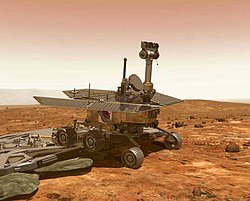Mars Climate Orbiter - mco marci
MARCI consists of nadir-pointed wide angle and medium angle cameras. Each camera has its own unique optics and identical focal plane assemblies, data acquisition system electronics, and power supplies. MARCI is mounted on the bottom (nadir pointing side) of the Mars Climate Orbiter. Each camera consists of a stray light baffle and lens elements and filters which focus onto an electronically-shuttered CCD. Without the baffle, the wide-angle camera is approximately 4.8 x 4.8 x 3.8 cm and the medium angle camera 5.4 x 5.4 x 5.5 cm. The wide-angle baffle extends an additional 1.4 cm and the medium angle baffle 2 cm. The cameras operate in push-frame fashion, in which a filter plate, consisting of multiple narrowband filter strips in the cross-track direction, is mounted over the detector. Consecutive images are taken each time the camera footprint advances one filter-width (about 20 pixels) in the downtrack direction. The images are 1000 x 1000 pixels in size. The MARCI operating temperature range is -40 to +70 degrees C and survival range is -80 to +100 degrees C.
The wide-angle camera has a field of view of 140 degrees. It has a dual lens system consisting of a five-element fused silica f/6 lens for short UV and a seven-element optical glass f/5 lens for longer UV and visible light. The optical paths of both lens systems are combined by a prism and dichroic beamsplitter, giving an effective focal length of 4.3 mm. It is capable of obtaining images in 7 spectral bands, 5 visible and 2 UV at a resolution of 7.2 km/pixel or better. The raw data rate from the wide-angle camera is 29.6 kbps per band.
The medium-angle camera has a field-of-view of 6 degrees. It has an f/2 catadioptric lens consisting of six elements, five of SiO2 and one of BK7, with an effective focal length of 87.9 mm. Images can be obtained in any of 10 spectral bands, ranging from 425 to 1000 nm, at a nadir resolution of 40 m/pixel. The raw data rate from the medium-angle camera is 704 kbps per band.Relevante Bilder
Relevante Artikel
Mars Reconnaissance OrbiterDer Mars Reconnaissance Orbiter ist eine NASA-Raumsonde zur Erforschung des Planeten Mars, die am 12. August 2005 zum Roten Planeten aufbrach und am 10. März 2006 ihr Ziel erreichte. .. weiterlesen






















